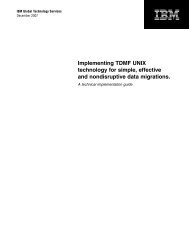A Primer for Healthcare Managers - IBM
A Primer for Healthcare Managers - IBM
A Primer for Healthcare Managers - IBM
Create successful ePaper yourself
Turn your PDF publications into a flip-book with our unique Google optimized e-Paper software.
12<br />
Phase 1: Determining a Sourcing Strategy<br />
When is a good opportunity <strong>for</strong> organizations to<br />
consider IT outsourcing? There are four plausible<br />
scenarios. First, the existing IT outsourcing contract is<br />
up <strong>for</strong> renewal and the service level is unsatisfactory.<br />
An organization is probably going to continue using<br />
IT outsourcing but needs to look <strong>for</strong> a vendor with a<br />
better fit. Another opportunity is the major upgrade<br />
of the existing IT infrastructure. This is usually a good<br />
time to think about the advantages and disadvantages<br />
of outsourcing IT infrastructure. The third possibility<br />
is a mandate from top management to quickly acquire<br />
new capabilities that are very difficult to acquire with<br />
existing in-house personnel. The last main scenario<br />
is when an organization is planning on reengineering<br />
its business process and may try to take advantage of<br />
capabilities available at vendors.<br />
Issues Related to Sourcing Decisions<br />
• Strategic Objectives<br />
• Extent and nature of organizational change<br />
• Labor implications<br />
• Management capabilities<br />
The sourcing decision should be in alignment with<br />
the organization’s long-term strategy. Client organizations<br />
need to integrate IT outsourcing into their<br />
strategic goals (McIvor, 2000). IT outsourcing should<br />
not be treated as an afterthought or last-minute<br />
solution to an immediate problem, but should be an<br />
integral part of organizational ef<strong>for</strong>ts to achieve longterm<br />
strategic goals. A strategic intent can be the<br />
improvement of existing IT services or acquisition of<br />
new service capabilities <strong>for</strong> business impact.<br />
A common strategic goal of outsourcing is to<br />
focus resources on core competence. When an inhouse<br />
IT service is not central to the organization,<br />
outsourcing it can help free up IT personnel to focus<br />
on the core. Network and application support, <strong>for</strong><br />
instance, may not be central to a human resources<br />
department. In this case, it is of strategic value<br />
to outsource network and application support to a<br />
vendor and transfer in-house IT personnel to assignments<br />
on core business activities.<br />
The process of deciding a sourcing strategy should<br />
also be thorough. A useful strategy is to go through<br />
the lists of benefits and costs associated with IT<br />
outsourcing mentioned in the previous section. In<br />
the list of benefit and cost items, emphasis should<br />
be placed on security and business continuity. For<br />
managers, one main question is whether vendors<br />
have a stronger capability than their own organization<br />
in meeting stringent security requirements <strong>for</strong> IT<br />
services to be outsourced. An IT outsourcing project<br />
is justifiable only when security concerns can be<br />
properly addressed. Business continuity should also<br />
be one top item on the strategic evaluation of an<br />
outsourcing project. The preparedness <strong>for</strong> disruption<br />
or changing priorities should be factored into an<br />
outsourcing project.<br />
Lack of thoroughness in checking all the cost/risk<br />
items may have serious consequences later on.<br />
One common problem is the underestimation of<br />
resource needs <strong>for</strong> managing an IT outsourcing<br />
relationship. Monitoring service per<strong>for</strong>mance,<br />
collaborating on service problems, and negotiating<br />
<strong>for</strong> changing service needs all require management<br />
and IT resources. A useful way of mapping main<br />
benefits and cost items is to think through the cost of<br />
the entire IT outsourcing process, even the cost of<br />
ending the contract (Bendor-Samuel, 2002).<br />
A careful analysis of sourcing strategy should go<br />
beyond checking the value proposition based on the<br />
advantages and disadvantages of IT outsourcing to<br />
address the full range of organizational implications.<br />
Organizational change, personnel change, and<br />
management capability are three main implications<br />
of IT outsourcing in any organization. An<br />
IT outsourcing arrangement usually implies a<br />
particular organizational change, such as closing<br />
an existing office or establishing a team working with<br />
vendors. Continuation of an existing outsourcing<br />
project with a different vendor does not involve<br />
a major shift of organizational culture or resource<br />
allocation. In comparison, outsourcing a service<br />
currently done within the organization may be a<br />
greater challenge due to the need <strong>for</strong> management<br />
practice and personnel changes.<br />
Building the management capability should be an<br />
integral part of a comprehensive sourcing strategy.<br />
Organizations need either to rely on their in-house<br />
expertise <strong>for</strong> evaluating IT outsourcing arrangements<br />
or to work with an IT consultancy when they<br />
need advice. At any rate, a strong base of technical<br />
knowledge and management know-how should be<br />
<strong>for</strong>med at this phase to carry out the tasks delineated<br />
at the second phase.

















